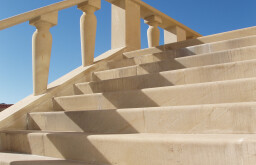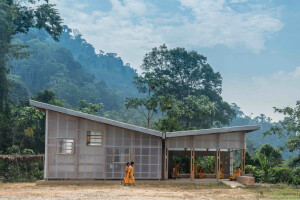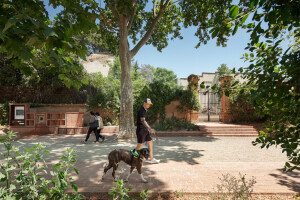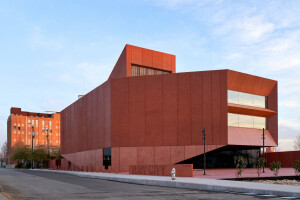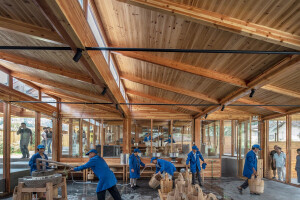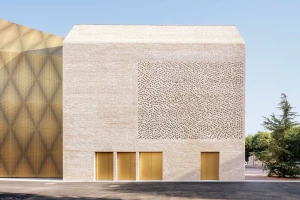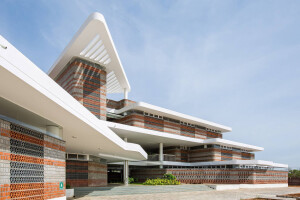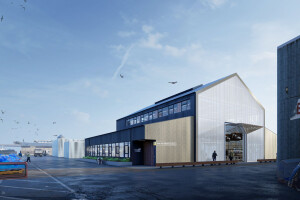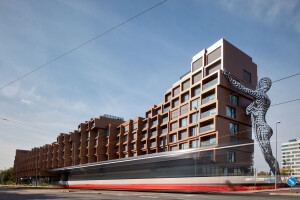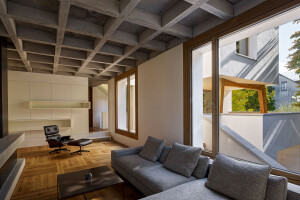Stone is a natural, low-carbon, robust, and reusable material. In construction, stone is a viable alternative to both concrete and steel, especially in terms of its compressive strength and lower carbon emissions. The Industrial Revolution spurred a shift away from traditional vernacular materials (such as stone, timber, and thatch) towards carbon-intensive, mineral-based materials (namely concrete and steel), the latter considered to be modern and forward-looking.
However, we know that construction and the built environment contribute significantly to annual global carbon emissions with a combination of operational carbon and embodied carbon. Embodied carbon emissions arise from the manufacturing, transportation, construction, and end-of-life phases of a building. A report by the World Green Building Council (Adams et al., 2019) notes that embodied carbon is largely overlooked, yet it accounts for around 11 percent of all global carbon emissions, particularly in terms of construction elements and materials. One way to tackle these emissions is to use materials with less carbon intensity.
Unlike concrete and steel, stone begins with zero carbon. Energy is required to extract stone from the earth and to process it, however the embodied carbon is still lower, especially when stone is locally sourced. Embodied carbon is further reduced when cutting equipment and transportation are powered by renewable energy sources.
It should be noted that stone’s journey as a revitalized alternative to building in concrete and steel is very much in its early stages when compared with the use of mass timber in construction (such as CLT and glulam).
The following educational establishments showcase contemporary and traditional applications of natural stone in terms of its practical, durable, environmental, and aesthetic qualities.
Located on the Tilburg University campus in the southern Dutch city of Tilburg, the Marga Klompé Building was designed by Powerhouse Company. Based on the principles of circular design, the building is constructed from solid wood with a Portuguese natural stone facade, a reference to the university’s 1962 Cobbenhagen building designed by architect Jos Bedaux. The blue-grey Muschelkalk stone has a long lifespan and can be disassembled and reused.
2. Rajkumari Ratnavati Girl’s School
Designed by Diana Kellogg Architects, the Rajkumari Ratnavati Girl’s School is located in the Thar Desert in Rajasthan, India. The school building’s imaginative oval structure was built by local craftspeople from hand-carved Jaisalmer sandstone, its form appearing to emerge from the surrounding dunes. The use of stone jali (openwork) provides the building with natural ventilation. The school is focused on educating girls and empowering women from neighboring villages in Jaisalmer, Rajasthan. “The oval forms were employed to reflect the curvilinear shapes of the local forts and also universal symbols of female strength,” says the architect.
Designed by Teğet Architectural Office, Sille primary school is located in the Greek-Ottoman village of Sille in Konya Province, Turkey. This traditional stone and wood building is conceived as a step towards the rehabilitation of the local village fabric — it is designed and built with a mix of traditional and contemporary techniques, helping to “establish a dialogue between the past and the present,” says the architect.
4. Naturalis Biodiversity Center
In Leiden, Neutelings Riedijk Architecten invited Dutch fashion designer Iris van Herpen to “interrupt” the stacked red travertine volumes of the Naturalis Biodiversity Center’s facade with white concrete friezes. The museum and research center’s exterior of stacked stone blocks is designed to resemble a geological structure. “The travertine was cut to reveal its red color and create a natural rough character,” says the architect.
The Jean Louis Étienne school in Coupvray, France, was designed by archi5. The building’s Hainaut blue stone creates a striking aspect in the school’s Marne valley setting. Hainaut blue stone is from the Hainaut province in southern Belgium. This natural stone is durable, ecological, and reusable.
The Collège Amadou Hampaté Bâ is located in Niamey, capital of Niger. Article 25 (a UK-based architectural NGO) worked on the refurbishment of existing classrooms and the building of new classrooms, administrative facilities, an assembly hall, and library. Passive design principles help to mitigate Niger’s year-round high temperatures. Laterite stone is the primary building material used for load-bearing walls and barrel-vaulted roofs — a corrugated metal top layer helps to pull air through the roof cavity, thereby alleviating interior temperatures. A locally available resource, laterite stone has a low embodied carbon footprint and its thermal mass regulates the release of heat during the day.
7. Geo- and Environmental Centre
The Geo- and Environmental Centre was designed by KAAN Architecten. Located in Tübingen, Germany, the building’s offices and meeting rooms enclose two inner courtyards that are characterized by meticulously constructed stone-clad facades and orderly rows of windows.
8. Ecole Communale Jacqueline de Romilly
Designed by Atelier Stéphane Fernandez, Ecole Communale Jacqueline de Romilly is a communal school in Cannes, France. The building is constructed using a rough sawn travertine stone with colors that range from a stronger ocher to softer sand. The stone’s high thermal inertia helps to regulate temperatures throughout the year.
The School of Planning and Architecture, Vijayawada (SPA Vijayawada) is a higher education institute in the city of Vijayawada, India. Designed by MO-OF / Mobile Offices, the school’s base is clad in a local Tandur stone with a river wash finish. The base houses workshops and laboratories for afternoon teaching programs — the stone cladding helps to mitigate solar heat gain in the hottest parts of the day.
The Jakoba Mulderhuis building is a part of the Amsterdam University of Applied Sciences’ (AUAS) Amstel Campus. Designed by Powerhouse Company and Marc Koehler Architects, the prefabricated facade is finished with natural Jura limestone.
Reference:
Adams, M., Burrows, V. and Richardson, S. (2019) Bringing embodied carbon upfront: Coordinated action for the building and construction sector to tackle embodied carbon. rep. World Green Building Council. Available at: https://worldgbc.s3.eu-west-2.amazonaws.com/wp-content/uploads/2022/09/22123951/WorldGBC_Bringing_Embodied_Carbon_Upfront.pdf (Accessed: 29 May 2024).
Related products
